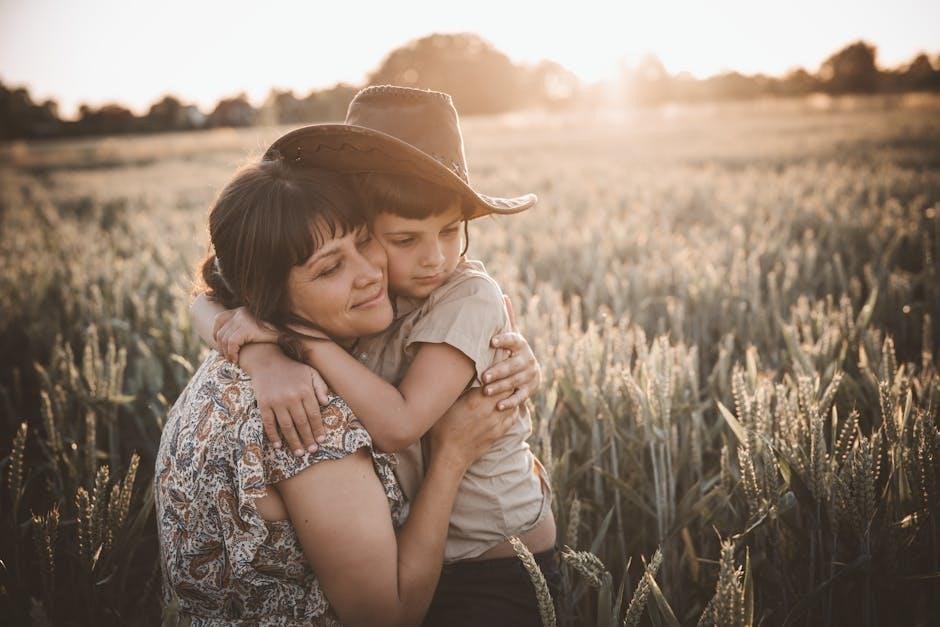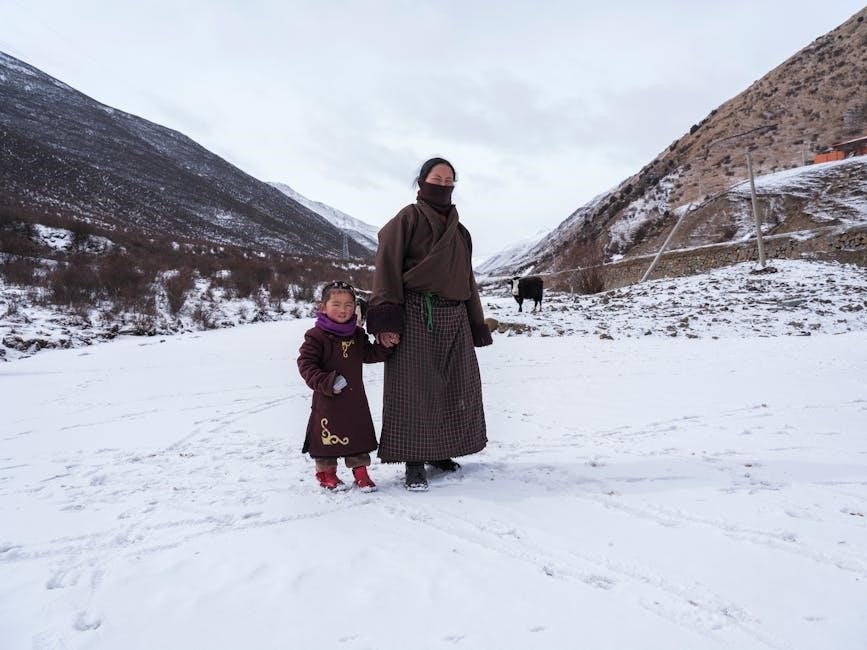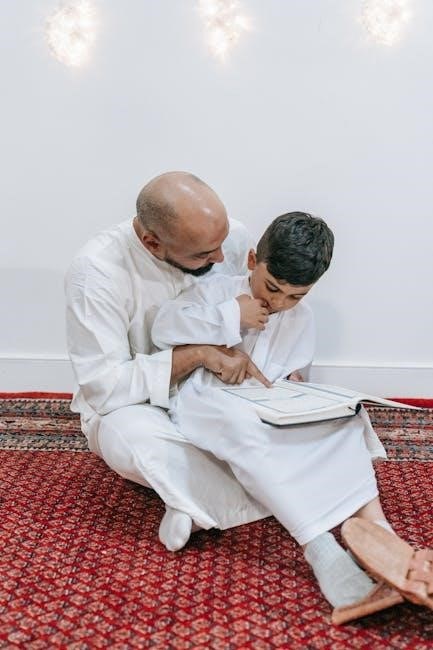Welcome to the comprehensive Parents Guide for the 2004 film The Village. This guide provides detailed content analysis, age suitability, and thematic insights to help families make informed viewing decisions. Explore key aspects like violence, themes, and intensity to determine if the movie is suitable for your child.
1.1 Understanding the Purpose of the Guide
This guide is designed to help parents understand the content of The Village (2004), enabling informed decisions about its suitability for children. The movie, rated PG-13, explores themes of isolation, fear, and community safety through its eerie and intense narrative. By analyzing violence, sex, nudity, profanity, and frightening scenes, the guide provides a detailed breakdown for parents. It also addresses moral lessons and discusses whether the film is appropriate for a 12-year-old. The purpose is to empower parents with the information needed to decide if The Village aligns with their child’s sensitivity and maturity level, fostering open discussions about its complex themes.
1.2 Overview of the Movie and Its Themes
The Village is a 2004 psychological thriller set in Covington, an isolated 19th-century village surrounded by mysterious woods. The villagers live in fear of creatures lurking in the woods, leading to strict safety measures enforced by the Elders. Themes of isolation, fear, and community safety are central, with the Elders’ protective efforts raising questions about safety versus obsession. The film explores love, sacrifice, and trust, creating a thought-provoking experience. Parents should recognize the movie’s eerie atmosphere and intense scenes, which may impact younger viewers, and consider its themes of courage and deception when assessing its suitability for children.

Age Suitability and Ratings
The Village is rated PG-13 for mature themes, violence, and brief strong language. While not excessively graphic, its eerie atmosphere and suspense may unsettle younger audiences. Parents should use discretion, especially for sensitive children under 13, as the film’s intense scenes and emotional depth are geared toward teens and adults.
2.1 PG-13 Rating and Its Implications
The PG-13 rating for The Village indicates that the film contains material that may be inappropriate for children under 13. Parents should expect themes of suspense, mild violence, and brief strong language. While the movie avoids excessive gore or explicit content, its eerie atmosphere and emotional intensity may still unsettle younger audiences. The rating suggests that parental discretion is advised, particularly for sensitive children. Teens aged 13 and older are likely to handle the content better, but discussing the film’s themes and scenes with your child can help them process the material appropriately.
2.2 Is the Movie Suitable for a 12-Year-Old?
While “The Village” is rated PG-13, its suitability for a 12-year-old depends on the child’s sensitivity and maturity. The film contains suspenseful and intense scenes, some violence, and emotional themes that might be challenging for younger viewers. Parents should use discretion, considering their child’s ability to handle fear and complex emotions. Watching the movie together can help gauge their reaction and provide an opportunity to discuss the themes. Mature 12-year-olds may find it engaging, but sensitive children might find it distressing. Parental guidance is recommended.

Content Analysis for Parents
This section offers a thorough analysis of the film’s content, including violence, mature themes, and language, to aid parents in making informed viewing decisions for their children.
3.1 Violence and Gore in the Movie
The Village contains suspenseful and violent scenes, including attacks by mysterious creatures. While gore is not overly explicit, some scenes may unsettle sensitive viewers. The film’s PG-13 rating reflects moderate violence, but it avoids excessive bloodshed. Parents should be aware of intense moments involving physical harm and the unsettling atmosphere created by the creatures. These elements may not be suitable for younger or easily disturbed children. The violence is often implied rather than graphically depicted, but its impact remains strong. This makes the movie appropriate for older teens but potentially challenging for younger audiences.
3.2 Sex and Nudity Content
The Village contains minimal sexual content or nudity, making it relatively safe for younger audiences in this regard. Romantic elements are subtle and not explicit. The film focuses more on suspense and drama rather than sexual themes. There are no scenes involving nudity or explicit sexual behavior. However, parents should still use discretion based on their child’s sensitivity to thriller genres. The absence of sexual content makes it appropriate for most viewers, though the overall tone may still require parental guidance for younger children due to the movie’s intense nature.
3.3 Profanity and Language
The Village features minimal profanity, with characters using mild language sparingly. The dialogue is generally respectful and aligns with the film’s serious and suspenseful tone. There are no instances of strong or repetitive swearing, making it suitable for younger audiences in this aspect. However, parents should consider the overall intensity of the movie when deciding if it’s appropriate for their child. The lack of excessive profanity makes it a relatively safe choice for viewers sensitive to strong language, though the film’s eerie atmosphere may still require guidance for younger viewers.
3.4 Alcohol, Drugs, and Smoking
The Village does not depict any significant use of alcohol, drugs, or smoking. The film’s focus on suspense and mystery overrides such elements, making it a relatively clean choice in this regard. Characters maintain a humble and disciplined lifestyle, reflecting the isolated community’s values. There are no scenes involving substance abuse or smoking, which makes it suitable for younger viewers in this aspect. Parents can appreciate the absence of such content, allowing the film’s themes and plot to take precedence. This aspect of the movie aligns well with its PG-13 rating and family-friendly elements.
3.5 Frightening and Intense Scenes
The Village contains several frightening and intense scenes that may unsettle younger or sensitive viewers. The film’s suspenseful atmosphere, combined with eerie visuals and unsettling sounds, creates a tense environment. Scenes involving the mysterious creatures in the woods are particularly harrowing, with moments of sudden fright. While there is minimal gore, the psychological horror and emotional intensity of certain sequences, such as the tragic backstory and dramatic plot twists, may be overwhelming for some children. Parents should use discretion, as the film’s themes of fear and isolation could linger in impressionable minds long after the credits roll.

Themes and Messages in the Movie
Explores themes of isolation and fear, emphasizes community bonds, portrays love as a powerful motivator, examines trust, courage, and sacrifice, offering profound lessons for audiences.
4.1 The Theme of Isolation and Fear
The movie delves into the theme of isolation and fear, portraying a village cut off from the outside world. The villagers live in constant dread of mysterious creatures lurking in the surrounding woods. This isolation fosters a deep-seated fear that permeates daily life, influencing decisions and relationships. The elders’ rules and the villagers’ shared beliefs reinforce this sense of confinement. Fear becomes a palpable force, driving both unity and tension within the community. This theme reflects universal anxieties about the unknown and the consequences of living in a world perceived as unsafe.
4.2 Community and Safety Measures
The village in the movie implements strict rules to protect its residents from the mysterious creatures in the woods. These measures include a beacon system and restricted movement after dark. The elders enforce these rules to maintain order and ensure everyone’s safety. The community’s unity is reinforced through shared responsibilities and adherence to these guidelines. Parents guide their children to follow the rules, emphasizing the importance of collective security. This system highlights the tension between safety and individual freedom, raising questions about the balance between protection and personal autonomy. The measures reflect a society prioritizing survival over exploration and curiosity.
4.3 Love and Relationships
The movie portrays love and relationships as central to the characters’ lives, particularly through the bond between Lucius and Ivy. Their relationship is built on trust, loyalty, and mutual respect, showcasing the power of romantic love. The village’s isolated setting intensifies emotional connections, highlighting the importance of human relationships in times of adversity. The elders also demonstrate paternal care, guiding the younger generation with wisdom. These dynamics emphasize the value of strong, supportive relationships, providing a positive message for parents to discuss with their children about healthy partnerships and the role of love in overcoming challenges.

The Setting and Plot
The Village is set in an isolated village surrounded by mysterious woods. The plot revolves around the villagers’ fear of creatures and their uneasy truce with the woods, creating suspense and tension.
5.1 The Village of Covington and Its Surroundings
The Village of Covington is an isolated, rural community surrounded by dense, mysterious woods. The villagers live in a tight-knit society, with a strong sense of unity and shared secrets. The woods are central to their culture, feared and respected due to the presence of unknown creatures. The village’s layout reflects its isolation, with homes closely grouped and a clear boundary between the village and the woods. This setting creates a tense atmosphere, emphasizing the villagers’ fear of the outside world and their reliance on tradition and elders for protection and guidance.
5.2 The Role of the Elders and Their Decisions
The elders in Covington hold significant authority, shaping the village’s rules and traditions. They enforce strict guidelines to maintain order and protect the community from the mysterious woods. Their decisions, often shrouded in secrecy, are meant to preserve safety but also foster fear and obedience. The elders’ leadership creates a controlled environment, limiting villagers’ understanding of the outside world. Their choices, though well-intentioned, raise questions about trust, manipulation, and the consequences of unquestioned authority. This dynamic provides a rich topic for parents to discuss with children, exploring themes of leadership, control, and the impact of decisions on a community.
5.3 The Mystery of the Woods
The woods surrounding Covington are central to the film’s suspense and intrigue. Believed to be inhabited by terrifying creatures, they instill fear in the villagers, reinforcing their isolation. The elders use these myths to maintain control, discouraging exploration. The woods symbolize the unknown, driving the plot’s tension and character motivations. Their eerie presence creates an atmosphere of dread, essential to the story’s unfolding mystery. Parents should be aware of the intense scenes involving the woods, as they may unsettle younger viewers. This element is pivotal in exploring themes of fear and the consequences of unresolved mysteries.

Moral and Ethical Lessons
The film explores trust, deception, and courage, highlighting integrity, selfless sacrifice, and the consequences of fear and control.
6.1 Trust and Deception
The movie delves into the complexities of trust and deception, as the villagers are manipulated by their elders to maintain control through fear. This theme raises questions about blind trust in authority and the consequences of withholding truth. Parents can use this to discuss the importance of honesty and the dangers of manipulation. The film also highlights how deception can lead to isolation and fear, offering a moral lesson on the value of transparency in relationships. It encourages critical thinking about when and why trust is broken and how it can be repaired.
6.2 Courage in the Face of Danger
The Village explores courage as a central theme, particularly through characters like Lucius, who embodies bravery despite his fears. The film shows how courage is not the absence of fear but the willingness to act in the face of it. Parents can discuss how characters risk their safety to protect others, highlighting selflessness and moral strength. This theme encourages children to think about standing up for what is right, even when it is difficult. The movie also portrays courage as a collective effort, emphasizing community support in overcoming adversity.
6.3 Sacrifice for the Greater Good
The Village illustrates sacrifice as a powerful moral lesson, where characters prioritize the well-being of their community over personal desires. Lucius and other villagers demonstrate selfless acts to protect their home, showing how sacrifice can uphold collective safety. The Elders’ decisions, though challenging, reflect their commitment to preserving the village. This theme teaches children the value of putting others first and understanding that difficult choices can lead to greater harmony. Parents can use this to discuss the importance of selflessness and the impact of individual actions on the community.

Reviews and Ratings from Trusted Sources
The Village holds a PG-13 rating, with Common Sense Media noting its suspenseful elements, and IMDb rating it 7.4/10, indicating acclaim as a thrilling, emotional experience.
7.1 Common Sense Media Review
Common Sense Media highlights The Village as a suspenseful, well-crafted film with strong performances. It praises the unique storytelling and atmospheric tension but notes the PG-13 rating reflects intense scenes. The review emphasizes themes of fear, isolation, and trust, making it unsuitable for younger or sensitive children. While it applauds the emotional depth and moral messages, it cautions parents about the eerie atmosphere and violent moments. The guide suggests parental discretion, especially for children under 13, to address potential fears and misunderstandings. This review helps parents decide if the film aligns with their child’s maturity level and sensitivity.
7.2 IMDb and Other Platform Ratings
IMDb rates The Village at 7.5/10, reflecting its engaging storyline and atmospheric tension. On Rotten Tomatoes, it holds a 44% approval rating, with critics praising its originality but criticizing its pacing. Metacritic scores it at 53/100, indicating mixed reviews. Other platforms like Amazon Prime and Google Reviews show similar trends, with audiences praising the film’s suspense and performances but noting its slow build-up. Parental reviews often highlight the need for discretion due to intense scenes, making it less suitable for younger or sensitive viewers. These ratings provide a balanced view for parents assessing the film’s appropriateness for their children.

Discussion Points for Parents and Children
This section provides engaging topics for parents to explore with their kids, fostering deeper understanding of the film’s themes, characters, and moral lessons, encouraging critical thinking and empathy.
8.1 Questions to Ask Your Child
Encourage open dialogue by asking your child about their feelings on the village’s isolation, the characters’ fears, and the elders’ decisions. Discuss how the villagers cope with danger and the role of trust in their community. Explore their thoughts on the mysterious woods and the creatures within. Ask how they would handle living in such a confined environment and what they believe is the importance of unity in times of fear. Inquire about their opinions on the sacrifices made by certain characters and how love influences the story. These questions help children reflect on the film’s themes and moral lessons.
8.2 Encouraging Critical Thinking
Engage your child by prompting them to analyze the movie’s themes and plot. Ask them to question the villagers’ beliefs and the elders’ decisions, encouraging them to think critically about fear and isolation. Discuss how the story’s twist challenges their initial perceptions and what they believe the filmmaker intended to convey. Encourage them to evaluate the moral dilemmas, such as whether the villagers’ lies were justified to protect their children. Talk about how fear can influence judgment and how courage is portrayed. This helps children develop analytical skills and understand complex emotions, fostering deeper comprehension of the story’s message.

Additional Resources and Guides
Explore additional resources such as parenting guides, educational websites, and discussion tools to help navigate conversations about ‘The Village’ and its complex themes effectively.
9.1 Books and Movies with Similar Themes
For families exploring themes like isolation and suspense, consider books such as The Lottery by Shirley Jackson or movies like The Sixth Sense and Signs, which share similar atmospheric tension. These resources provide opportunities to discuss fear, trust, and community dynamics in a broader context. They also offer a gateway to understanding psychological thrillers and moral dilemmas, aligning with the emotional depth of The Village. These recommendations can enrich your child’s understanding of complex storytelling and encourage deeper conversations about the film’s themes and messages. They complement the guide by offering diverse perspectives on similar ideas.
9.2 Occupational Therapy and Autism Resources
For parents seeking additional support, resources like the Autistic Self Advocacy Network (ASAN) and the Autism Society offer valuable tools. Occupational therapy strategies can help children process sensory-intensive scenes in The Village. Tools like social stories and sensory integration activities can aid in discussing the film’s themes of isolation and courage. These resources also provide guidance on fostering emotional resilience and understanding complex social dynamics, which are central to the movie’s narrative. They empower parents to create a supportive environment for children with autism or sensory sensitivities, enhancing their ability to engage with the film’s deeper messages.
The Village offers a thought-provoking experience, blending suspense with emotional depth. Parents are encouraged to use this guide to make informed decisions, fostering meaningful conversations and ensuring their children engage with the film’s complex themes safely and mindfully.
10.1 Making an Informed Decision
Parents should carefully evaluate The Village based on their child’s sensitivity and maturity. The film’s suspenseful atmosphere, intense scenes, and complex themes may not suit all younger viewers. While the PG-13 rating provides a general guide, individual tolerance for fear and emotional depth varies. Consider discussing the movie’s content beforehand to prepare your child for its unsettling elements. Reflecting on their ability to differentiate fiction from reality is crucial. Ultimately, this guide aims to empower parents to make choices that align with their child’s emotional and developmental needs, fostering a safe and enriching viewing experience.
10;2 The Importance of Parental Guidance
Parental guidance is essential when introducing children to The Village, as its complex themes and eerie atmosphere may provoke strong emotions. Parents should actively engage with their children, fostering open conversations about the film’s content. This helps children process unsettling scenes and themes, ensuring they understand the context and intent behind the story. By addressing sensitive topics and reassuring their children, parents can mitigate potential fears. Additionally, guidance encourages critical thinking about the movie’s moral lessons and emotional depth. This collaborative approach not only enhances understanding but also strengthens the bond between parent and child, fostering emotional growth and awareness.

Frequently Asked Questions (FAQs)
- Is the movie too scary for young children?
- What are the main themes parents should discuss?
- Is the PG-13 rating appropriate for teenagers?
- Are there any intense scenes that might upset kids?
11.1 General Questions About the Movie
Parents often ask if The Village is suitable for children due to its eerie atmosphere and suspenseful plot. The movie’s PG-13 rating reflects moderate violence and intense scenes, which may unsettle younger viewers. Questions about the film’s themes, such as isolation and fear, arise frequently. Many wonder if the movie’s twist ending is appropriate for teenagers. Additionally, inquiries about the film’s pacing and whether it aligns with a child’s maturity level are common. These questions help parents gauge if the movie aligns with their child’s sensitivity and understanding.
11.2 Safety and Privacy Concerns
Parents may worry about the movie’s suspenseful and intense scenes affecting their child’s sense of safety. The villagers’ fear of the unknown and the eerie atmosphere might trigger anxiety in younger viewers. Privacy concerns arise in how the village’s isolation impacts personal freedom. The film’s controlled environment and lack of outside interaction could provoke discussions about autonomy. Parents should consider their child’s sensitivity to such themes and address any fears or questions openly. Ensuring children understand the fictional nature of the story can help alleviate concerns and foster a safe viewing experience.
